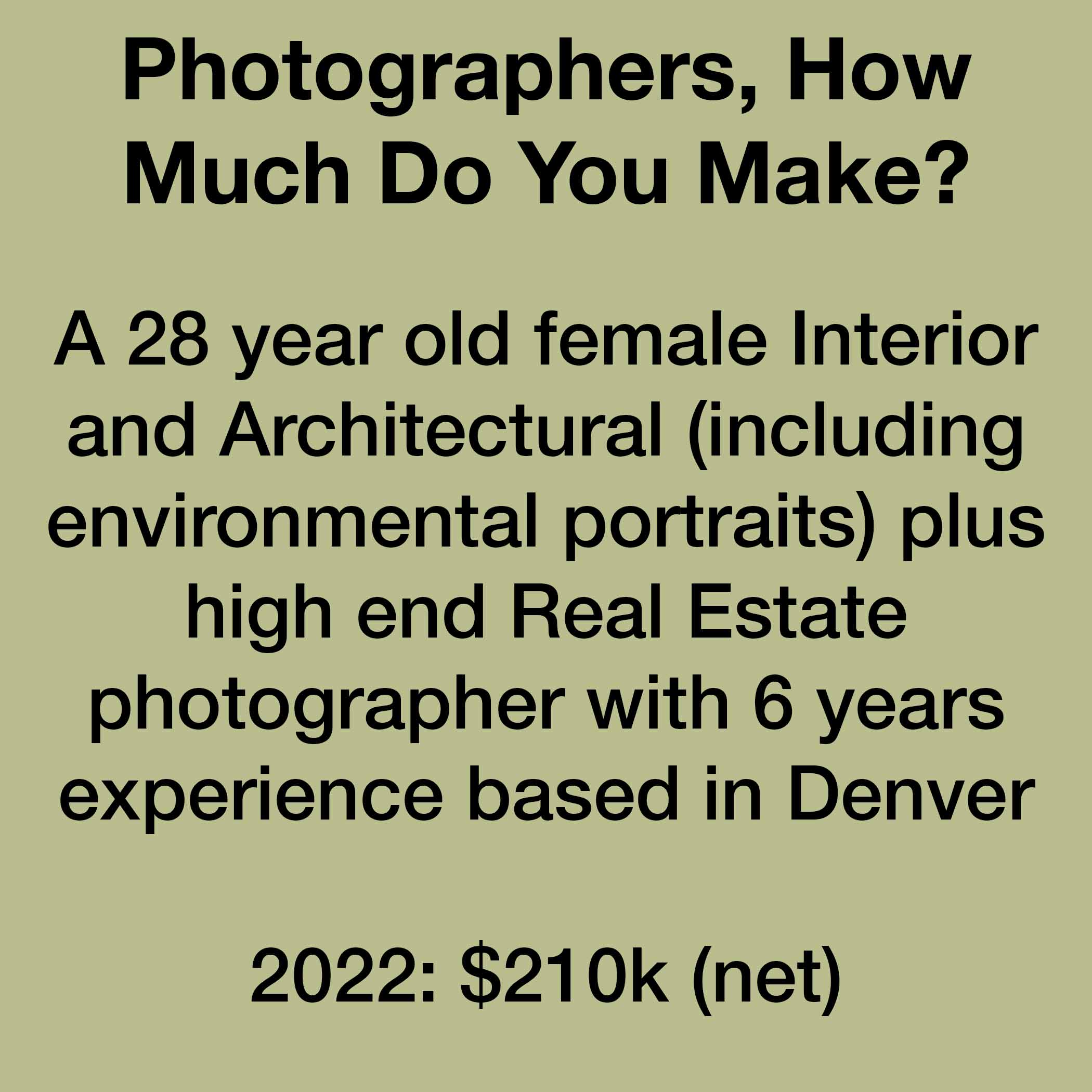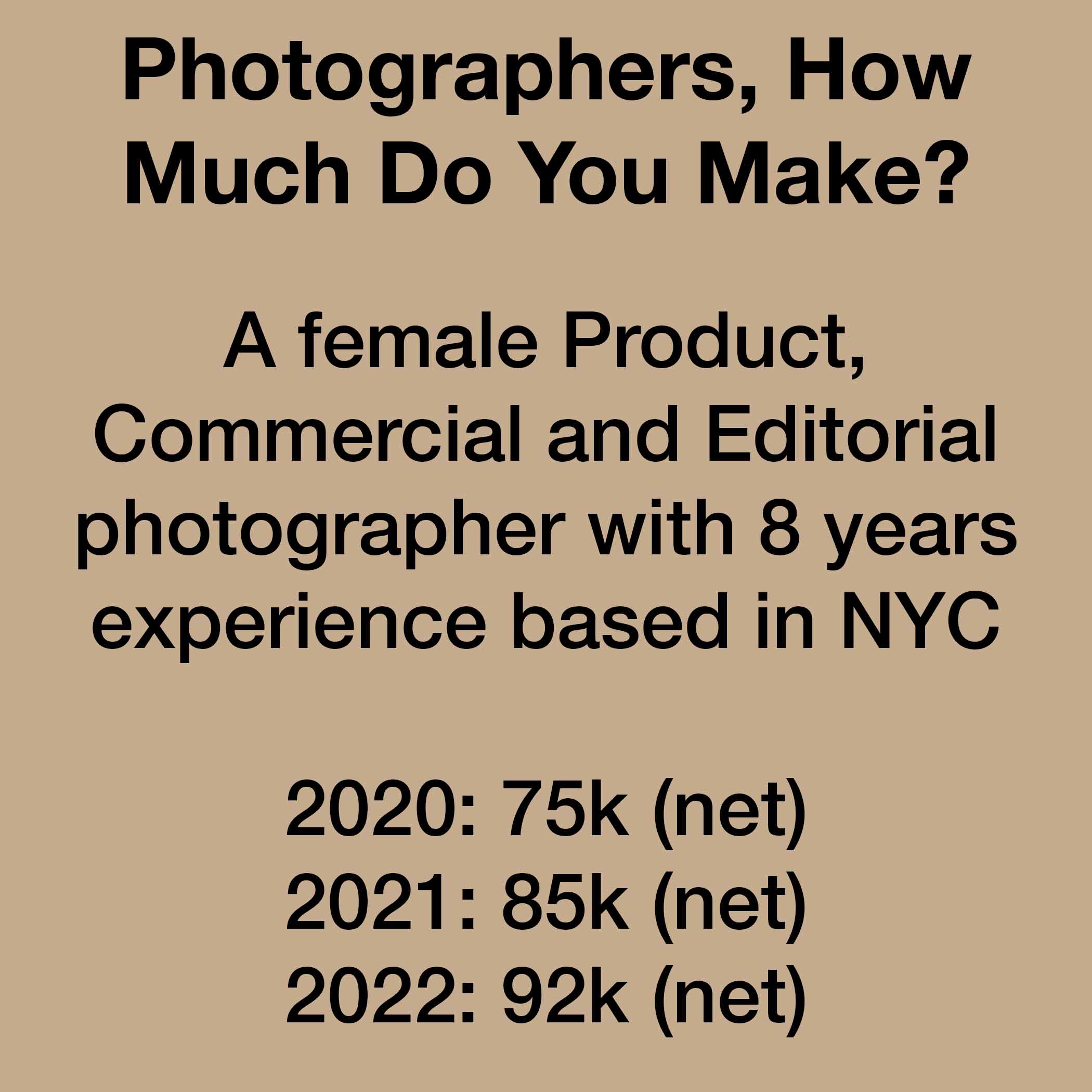I produce a lot of shoots for my clients so my gross is high, with talent, location, HMUA, stylists, etc. My income is 60% product, 30% beauty, 10% fashion/portrait projects. Most are regional / national beauty brands, I have shot for a few Fortune 500 but not consistently. A couple of my clients are based in South Florida, others spread across the nation. Most of my clients are national beauty brands with 10-50 employees, some are B2B some are B2C. A lot of my clients tend to be repeat clients as well, 75% of them book me again down the road.
My wife works with me as a prop stylist and production manager, other than her I have no full-time employees. I usually hire talent as needed for each job, assistants, digi-tech, etc.
I have my own studio space which all in costs me around 65k a year. Most of my work is shot in studio and I prefer to have my own instead of renting a studio when I book shoots. I charge most of my clients a studio rental fee anyhow so it helps cover cost. Other than my studio, my only other costs are gear & maintenance.
I work full time, usually taking 3-4 weeks throughout the year for vacay. I tend to shoot around 100-150 days a year, other time is spent on post production and business management.
My income has increased steadily year over year.
All my income is through my photography business, however I started offering more services to my clients, which allowed my to increase my income. All in all, I’m a one-stop-shop that offers beauty, product, video and production. It definitely keeps me busy, but it increases my fees, makes it easier for my clients, and makes me less replaceable.
Most of my shoots tend to be 1-3 days, capturing different style of content each day:
-Models in studio shooting video and stills.
-Product only, usually in studio Lifestyle content capturing models and product, usually on location.
I spend 1-2 full days culling and editing images to send to my clients. After that, I charge by the image for retouching and outsource it 90% of the time.
My day rate ranges between $2500-4000 and I usually charge usage on top of it. For my smaller clients I pad my day rate and include usage with it. My wife works with me as a prop stylist and production manager, between the two of us our average take-home after is expenses is usually $4-8k per day.
Best paying shoot last year was a 3-day production shooting lifestyle content for a luxury brand. Day rate was $3500, usage was 3 years @ $5000. All-in, my take-away was $17k.
Worst paying shoots for me tend to be editorials for local based regional magazines, I did a portrait feature for a cover shoot that only landed me $500 for a half-day shoot. I often don’t mind working with these magazines because I look at it as a form of marketing that pays me and sends clients my way.
Video is currently only about 10-15% of my income, but I see if increasing in the coming years.
Know your worth and charge accordingly, an under priced production isn’t only hurting you, it hurts the entire industry. In a market where everyone has a camera in their pocket, it’s getting harder and harder to charge for professional photography. Set yourself apart and charge for it, damnit!!!
My income has only grown in the last 5 years, covid didn’t really slow down the home photography sector much.
I aim to book clients on a full day shoot (8 hours shooting + normally 8 hours editing) where licensing terms are pretty generous (print, web and social marketing), editorial publishing is a separate fee to be negotiated by the publisher. Additional licenses can be purchased depending on number of parties interested.
My best recent shoot was a one day $6500 shoot with one day editing with a few licensed users on the shoot.
I don’t shoot video.
I’m honestly pretty terrible at marketing, so much has been through word of mouth. I do minimal (read: lazy) Instagram.
For retirement I use a company called Ellevest that allows me to easily put away money to invest on a monthly basis.
Worst advice I have received was to keep working a full time editing position right out of college because i wouldn’t be able to make much more than that on my own. Some of the best advice was to be open with other photographers in your market about pricing – the only people benefiting from us being secretive about pricing and back end details are those paying us.
Be an active part of / create a community within the photographers in your market. Working solo requires you to make these connections which can be invaluable when seeking out advice, or just wanting to talk about all of the very niche day-to-day within the industry.
I love a creative job, but i find that i most enjoy working with clients that actually respect me, as a creative but as a human being, and working with nice people can sometimes outweigh anything else.
Create work/life balance and healthy boundaries. iI have a separate phone for work/clients that I don’t really check after hours or on the weekends.
I’m a full-time, in-house photographer for a small-medium sized company in Florida. Total compensation is about $83,000 ($70,000 salary base + $13,000 benefits). I get yearly raises at about $4,000-6,000. Bonuses are also possible in years where company profits are good. Company revenue ranges from 20-25 million annually. I shoot Product and Lifestyle for the company I work for and then some food and real estate on the side.
I don’t use any of my own personal studio equipment. The company purchases all equipment I need to do my work. The company, at my request, bought me a Canon R5 + lenses when I was initially employed. I work out of a dedicated studio at the company’s headquarters.
I’ll work from home on days that I’m editing photos and/or video. I’ll travel abroad for shoots once or twice a year, for no more than 5 days at a time. We usually travel to a large city (Chicago, Miami, etc) for those shoots. I’m always home for the weekends.
I’m part of a small creative team, including a creative director and a producer. Together, we make up an in-house agency of sorts to execute the content needs for the company. We produce everything from simple social content to full-on TV commercials that run nationally.
I work Monday-Friday 9a-5p (paid holidays + 16 days PTO).
The company I work for is wonderful. They’d be a dream client if I shot for them freelance.
I’ll shoot local food and real estate gigs on the side when they come up and when I have time.
I do not own the copyright to any of the work I produce for the company that employs me. That’s one of the defining differences between in-house, salaried photographers and freelance photographers.
The majority of my in-house work is photography, but it’s probably a 60/40 split with video work. Nearly every shoot incorporates both stills and motion. The company may hire a dedicated in-house videographer in the future, but in the meantime, I produce the video in addition to the photography. I came to the company with only some video experience and I’ve learned much since being hired.
Freelance vs in-house photographer: each has its pros and cons. You have to weigh each of the pros and cons and decide which one works for you and your desired outcome and goals.
My income would be pretty low in a big city where cost of living is high. Fortunately, the company I work for isn’t located in a big city and my cost of living is pretty low. It’s one of the many variables you’d have to consider if you were to choose an in-house position.
Don’t be a photographer is simultaneously the best and worst advice I have received.
8 years total, 5 years in-house (making 90k), 3 years freelance.
Most of my clients are small to medium business based on the East or West Coast. A few larger commercial clients.
Between 2-4 shoots a month.
My best shoot was 15k for a two day shoot, 8 hours per day, 3-4 days of post, 1 year licensing.
My worst shoot was 1500 for a 1 day shoot, 10 hour day, 3 days of post, unlimited usage rights.




